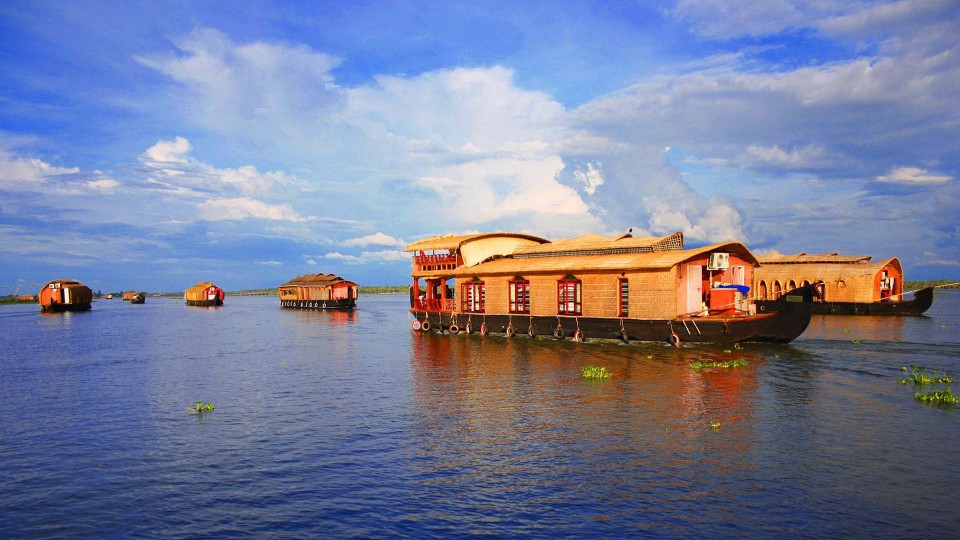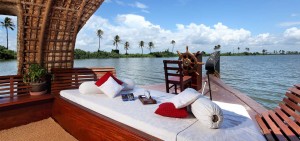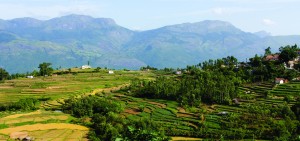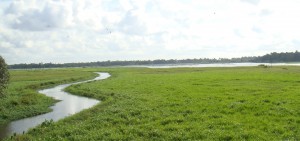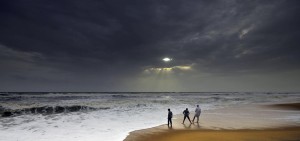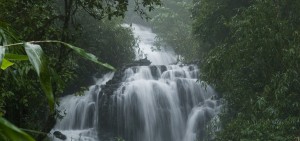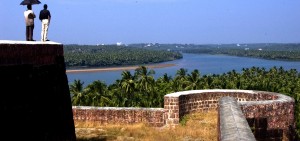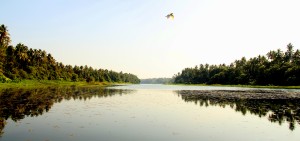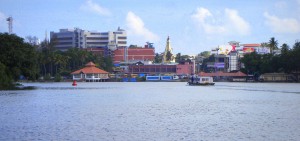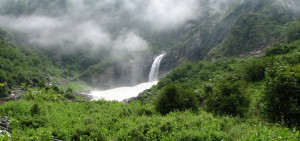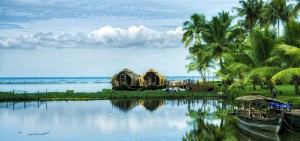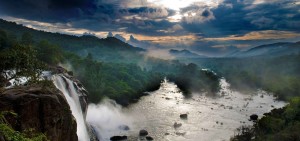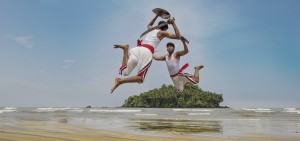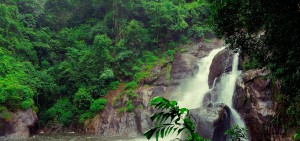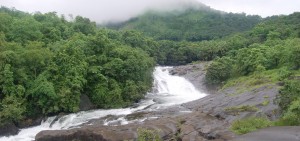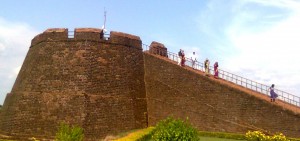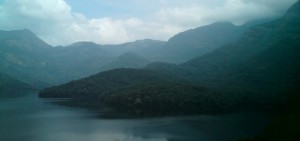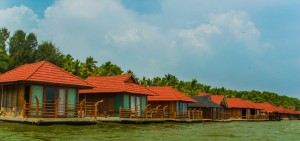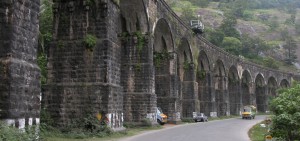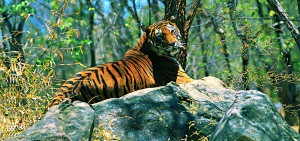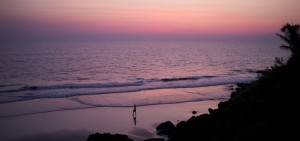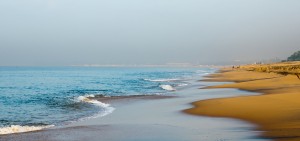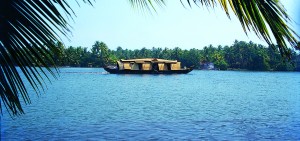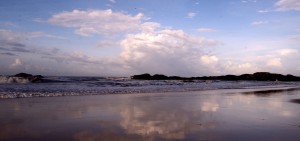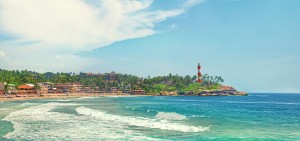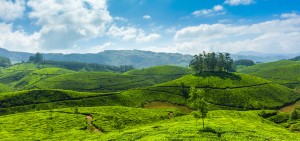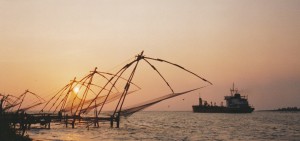About
Contents
1 Understand
1.1 Geography
1.2 History
1.3 Climate
1.4 Religion
1.5 Culture
1.5.1 Dance
1.5.2 Music
1.5.3 Martial arts
1.5.4 Drama
1.5.5 Cinema
1.6 Traditional dress
1.7 Government
1.8 Economy
Understand[edit]
The Athirappilly Falls
The Chinese fishing nets of Kochi
The tourism department of Kerala boasts that the state is God's Own Country. Once you visit, you will see where this claim comes from. The state really is blessed with great natural beauty.
The state is also considered to be one of the safest regions of India. Incidents of local people cheating tourists are almost non-existent. Kerala has high standards of living compared to its neighbours and other Indian states and has indices such as education and healthcare that are on a par with developed countries. Therefore, tourists can relax without being followed around by taxi drivers, touts or guides, though there are some beggars who have migrated from poorer states. Abundant rainfall means that you can find lush greenery that remains pretty much throughout the year. A holiday here is an opportunity for rejuvenation. You can get an Ayurvedic oil massage, spend a day or two on a houseboat with nothing to do but watch coconut trees pass by, or just laze around on Kovalam or Varkala beaches. Thus, tourism is more experiential here, rather than being devoted to seeing highly touristed sights. Kerala was named as one of the "ten paradises of the world" and "50 places of a lifetime" by the National Geographic Traveler magazine.
Geography[edit]
Kerala is wedged between the Western Ghats on the eastern side and the Arabian Sea on the west, thus having a wide range of topography from high altitude mountains to golden beaches, and is criss-crossed by 44 rivers. The tributaries, unique backwaters, lagoons and numerous small islands provide many scenic attractions for visitors.
History[edit]
The ancient period saw the rise and fall of the first and second Chera empires, which were the only two periods when Kerala was united under a monarch. Kerala is mentioned in the writings of many Greek, Roman, Arabic, European and Jewish travelers and merchants from the 1st millennium BCE. It was known for the spices that were grown in the lush hills of the Western Ghats. During the Middle Ages, there were three powerful kingdoms - Kolathiri/Cherakal in the extreme north, Samuthiri/Zamorin in Calicut (north and central), Travancore in the south. The Portuguese were the first to discover a direct sea route between Lisbon and Calicut in Kerala, and this marked the beginning of European colonisation in the country. Soon the Dutch, French, Italians and British were all lured by the wealth of spices and silk, and came with the intention of forming colonies. The defeat of the Dutch by the Travancore Army at the Battle of Colachel, and the decline of Portuguese Empire and French problems in Europe, resulted in the British gaining the full influence in India, and the annexation of the Malabar region (Kolathiri and Samuthiri) into the British Madras Presidency.
However, the Kingdoms of Tiruvithamkoor (Travancore) and Kochi (Cochin) enjoyed some autonomy under the British. After Indian independence, the kingdoms chose to accede into the Indian Union, and were later merged into a single State of Travancore-Cochin. With the linguistic reorganisation of States, the Malayalam-speaking regions of Malabar and Travancore-Cochin were integrated into the State of Kerala on November 1st 1956. This realised a united Kerala, a dream held since the partition of the ancient Kerala Empire of Cheras in the eighth century. Today, people in Kerala live a largely traditional lifestyle, and much of the rich culture and heritage of the region is well-preserved.
November 1st is celebrated as Keralappiravi (Birth of Kerala) Day (also observed as Malayalam Divasam or Malayalam Day).
Kerala also played host to the first Jewish, Christian and Muslim communities of India. While the Jewish population declined following the establishment of Israel, Kerala still has a synagogue in Kochi. Kerala is known for its secularism and peaceful co-existence and brotherhood of the three major religions - Hinduism, Islam and Christianity.
Climate[edit]
Kerala, being very close to the equator, has a tropical climate. Kerala experiences heavy rains almost throughout the year, and is one of the wettest areas on Earth.
Kerala has three distinct seasons:
Summer lasts from mid-February to mid-May. The tropical sun is really hot and temperatures can go up to 35 °C (95 °F) in the afternoons.
The South-East monsoon is in place from mid-May until early September. Also the North-East Monsoon winds bring heavy showers.
Winter is mild and lasts from about mid-October to early February. Heavy rains occur from the last week of September until early November, due to the retreat of the South-East monsoon. There is no snow in Kerala, although it is quite cold and misty in the mountain regions.
When in Kerala, carry an umbrella no matter what time of the year it is. You can be caught in a sudden shower in summer which will leave you drenched if you are unprepared. The Kerala sun coupled with the high rate of humidity can be unforgiving in the summer months.
The temperature averages around:
28°C–36°C daytime, 24°C–28°C at night in summer seasons of March, April
20°C–28°C daytime, 18°C–25°C at night for the rest of the year
Temperatures may drop down to 10 °C (50 °F) or lower during November and December in hilly areas of the Western Ghats, especially at popular hill-stations like Munnar and Wynad. This results in misty days and freezing nights coupled with light cold showers. However, in other places, the temperatures never drop below 15°C.
Summers have become hotter: though the maximum temperature has never risen higher than 36°C, the rising humidity has made summers difficult. The height of the Kerala summer is normally between mid-March and May. Wear only light, loose cotton clothes during this season. Consider a trip to hilly areas, where the temperatures never exceed 26°C.
Kerala experiences mild winds throughout most of the year.
The most pleasant time to visit is from September to March, when the weather is ideal for sightseeing, trekking and boating.
Religion[edit]
Hinduism is the largest religion in the state. Hinduism in Kerala is bit different to other parts of India, due to assimilation of traditional Dravidian culture, and later due to the unique practice of Marumakathyam (matrilineal system), which made the society highly matriarchal unlike patriarchal values found else where in India. This also helped the society to be highly tolerant to cross-caste/religious marriages and co-living systems. Also, Kerala is the last place in the world where ancient Hindu Vedic Tantric rites are practiced widely.
Kerala's Islam is also unique. Kerala's trading relations with West Asia brought Islam to its shores around 600 CE soon after its formation in Arabia, through Arab Traders. Islam entered Kerala with an official fanfare and patronage from the ruling Hindu Chera Emperor and since then, Islam has become one of the most popular religions in the state. Unlike other parts of India, Kerala Muslims are mainly descended from Arabs through inter-religious marriages between fisherman families, who are thus called Mappillas (meaning sons-in-law). Unlike other parts of India, Muslims were given high-profile rankings in Kerala society by ruling Hindu Rajas and many of them are placed as close companions of ruling elite. Kerala's Islam is slightly different from Islam from other parts of South Asia, as Kerala follows the Shafi'i School of Islam like many Arab countries such as Yemen, and unlike the Hanafi school elsewhere in India.
Christianity, too, has made a unique mark in Kerala's history. St. Thomas the Apostle came in 52 CE and spread the message of Christ. This resulted in a large influx of Syrian immigrants who soon assimilated with the locals. Kerala has the largest number of churches in India. In terms of denominations, Kerala is home to Roman Catholic Latin Rite, Syro-Malabar and Syro-Malankara denominations, two major Orthodox denominations, two major Protestant denominations and one Nestorian church, apart from innumerable Charismatic/Independent congregations.
For thousands of years, Buddhism was the most influential religion in Kerala. It was only in the 11th and 12th centuries that Brahmanism took hold in the state and Buddhism waned. Today the state has a small Buddhist population and almost all famous Buddhist temples in Kerala has been converted into large Hindu temples, some still having Buddhist saints worshiped. The famed Vadakkumnath Temple in Thrissur was a large Buddhist Vihara, which was converted into a Hindu Temple.
Another minority religion is Jainism, with a fairly small number of followers in Wayanad, Kozhikode and Kochi. Jainism reached Kerala during the Maurya period, when the Great Mauryan Emperor Chandragupta Maurya retired to Shravanabelagola near Mysore in 3rd century BCE, though a large number of Jain monks accompanied him. Jainism became extremely popular in Kerala, with large number of Jain temples, until 6th century CE when there was a revival of Hinduism in Kerala. The decline of Jains resulted in many Jain temples being converted into large Hindu temples. The classic example is the famous Irinjalakoda Bharatha Temple which originally was a Jain temple dedicated to Saint Bharatheswara, a Jain monk, which was converted into a Hindu Temple in 5th century CE as Lord Bharatha (Brother of Sree Rama). Many Jain temples later got demolished during Tipu Sultan's raid.
There are also a lot of followers of Sikhism in the state, mainly those who have migrated from the Indian state of Punjab.
Judaism has existed in Kerala for about 2,000 years, and today a minority of Jews live around Kochi, although there was a mass migration in the 1950s following the founding of Israel. Jews arrived in Kerala during the Crusades when the fall of Jerusalem caused a large number of Jewish immigrants to take refuge in Kerala. The Chera Kulashekara Emperor invited Jews to settle down in Kochi and Kollam areas and issued them various grants and privileges. Unlike elsewhere, Kerala is one of the few places in the world where Jews lived peacefully with Muslims and Christians. Cochini Jews became the largest segment of Jews and several famous synagogues were established, though the first Jewish synagogue, which was established in the 15th century (the Commonwealth's oldest synagogue), is the only remaining one. During Portuguese rule, several synagogues were raided and many were demolished, until the Kochi Kingdom officially asked the Portuguese to stop attacking Cochini Jews. Following the establishment of the modern State of Israel in 1948, most of the Cochin Jews moved to Israel, and only a small number remain in Kerala today. This resulted in the existence of only two synagogues in Kerala: the Paradesi Synagogue of Mattachery (must see while in Kochi) and a small one in Paravur. Synagogues are off-limits to tourists on Saturdays as it is the Sabbath.
Due to its strong socialist values and history of several communist movements, there are a considerable number of atheists in the state.
Hindus constitute about 56% of the population, Muslims 24% and Christians account for about 19%. Communal and sectarian tensions are rare. Kerala is considered the most peaceful place in South Asia.
Culture[edit]
Unique to Kerala, the Malayalee culture is derived from ancient Tamil-Dravidian practices combined with Arya-Indian culture, with influences from China, Japan, Arab countries, Portugal, Holland and even from the British. There are a lot of Tamil-Sanskrit elements, resulting in many unique practices and customs. Each community in Kerala has its own unique version of Malayalee culture which will not be found anywhere outside Kerala.
Hindu influence brought Ayurveda (a system of medicine) into prominence. Kalaripayattu (Kerala's traditional martial art) adopted many Hindu practices. While religious beliefs and their associated myths and legends are well rooted in the Malayalee psyche, the influence of communism and the Kerala renaissance has resulted in separation of religion from the daily routine of life.
Kerala architecture has lot of Tibetan-Chinese influence, due to its seclusion from other parts of India when the Western Ghats precluded Tamil influence. Most of the buildings have gabled, tiled roofs and a heavy use of wood with prominent slanting windows and ornamental flora designs. The Sree Padmanabhapuram Palace near Thiruvananthapuram is a classic example of this style.
Dance, music and drama all have distinctive styles. Dance and music performances often attract large crowds.
A good way to experience the entire spectrum of arts and culture of Kerala in one place is at the Annual Kerala State School Art Festival, normally held in December or January. The location changes between various district headquarters on a rotational basis. This was constituted by the government as a competition amongst school children to promote Kerala arts and culture. This is Asia's largest festival according to the Guinness Book of records, with more than 82 art forms show-cased during its ten-day duration.
Dance[edit]
Kathakali, the lone Indian classical dance drama, originated from Kerala
Kerala has numerous indigenous dance forms.
Chavittu Nadakam (Malayalam: ചവിട്ടുനാടകം). This is a highly colorful Christian classical art form that originated in Gothuruth village, North Paravur. It is noted for its attractive make-up of characters, their elaborate costumes, detailed gestures and well-defined body movements presented in tune with the rhythmic playback music and complementary percussion. This art form highly resembles European opera. Chavittu Nadakam is believed to have originated during the 16th century AD. This form of play is prevalent among the Christian community in the districts of Alappuzha, Ernakulam and Thrissur.
Kathakali. Kerala's celebrated classical ballad with use of large costumes and elaborate make-up. It is a dance drama, noted for wide range of characters. Each character has a special kind of costume and make-up, special movements, particularly extensive expressions, refined gestures, and innovative themes. The dance is accompanied with anchor music and precise drumming. The Kathakali Music is unique as it varies in accordance to expressions and reactions. Whilst traditional Indian epics, mainly the Ramayan and Gita Puran, constitute the main story-boards for the dance drama, many international versions like Shakespearian-Homer-Biblical works are now taken as themes. A glimpse of Kathakali can be seen in shows organised by various cultural centres across Kerala (including the ones at Thekkady), which showcase the art and educate people about it.
Koodiyattom. An ancient form of theatre with a legacy of more than 2,000 years. This is very stylised Sanskrit theatre and recognised by UNESCO as a Masterpiece of the Oral and Intangible Heritage of Humanity. Most of the characters are noted for Sanskrit recitations and highly stylised movement, particularly eye expressions. Some parts of the stories are expressed only using the eyes.
Margam Kali (Malayalam: മാര്ഗ്ഗംകളി). One of the ancient group dances of Kerala practised by Saint Thomas Christians. The Margamkali is a ritual folk dance in which twelve people dance around a traditional oil lamp (Nilavilakku). They represent the 12 apostles, and Christ is represented by the lamp. They perform the dance wearing the traditional white dhoti and a peacock feather on the turban. Margamkali is essentially famous among the Syrian Christ of Kottayam and Thrissur districts.
Mohiniyattom. This classical artform of Kerala is a subtle and graceful dance performed by women in traditional costume. Most of the themes are poems, unlike other classical dances which have an emphasis on Hindu mythology.
Theyyam. This is a ritualistic rite performed in the temples of Malabar. It is an ancient tradition, whereby worship takes the form of performance, rather than formal worship. While dressed in Theyyam costume, performers are considered Gods and Goddesses. There are nearly 41 various types of Theyyam, each noted for its different legend and stories. A visit to any Malabar temples during Theyyam season (Dec-Mar) is advised.
Music[edit]
Kerala has its own indigenous music and orchestration.
Melam. This is a percussion ensemble, with several variants differing in the number of percussive instruments used, as well as the style of playing them. Melam is extremely popular and is mostly used during temple festivals, when more than six hours of continuous playing is the norm. Melam attracts large crowds and creates wonderful notes. The Thrissur Pooram has the largest Melam, with more than 300 musicians in the ensemble.
Sopanam. Kerala's unique classical music has slow, graceful rhythms. Most of the original versions are poems, and the music is coupled with poetic expression and style. Sopanam is now limited to regular performances at temple events.
Mappila songs. This music is associated with the local Muslim community. Traditionally, the songs were performed in Mappila Malayalam - a mixture of Arabic and Malayalam - and most tell stories of social systems and customs. Today, Mappila songs are popular amongst youngsters, using Malayalam lyrics. Mappila songs have a charm of their own as their tunes sound a mix of the ethos and culture of Kerala as well as West Asia.
Poems play a pivotal role in Malayalee music culture. Kerala is extremely well known for its various famous poetic traditions, and a large number of poems of high literary value. Aksharaslokam (Poem recitations) is a common sight in many village temple platforms and during festival times, where poets recites poems and challenge other poets to start their recitation with the phrase, the former has ended his recitation
Film Music. As elsewhere in India, film music is extremely popular, and Malayalam songs can be heard everywhere.
Martial arts[edit]
Kalarippayattu (Kalari) is believed to be one of the oldest martial arts in the world. Kalaripayattu has many styles, the best known being Northern Style and Southern Style. While former is focused on using various weapons, the Southern style uses powerful strokes with the bare hand. The knowledge of vital spots, known as Marma, on the human body helped Kalaripayattu warriors make blows that could freeze or kill a person.
Bodhidharma, a Buddhist monk, mastered Kalaripayattu while in Kerala, and later took it with him to China while he was spreading Buddhism. He taught it to the Buddhist monks in China, which gave rise to Shaolin Kung Fu, which in turn, gave rise to all other forms of Kung Fu, as well as Karate.
The British Government passed legislation banning Kalari, considering it a potential danger, and this resulted in a brief decline. Today, it is a popular sport and exercise option which gets international attention. There are many cultural centres which showcase Kalari techniques, one of them being the Kalari Centre at Thekkady, as well as schools in Thiruvanathapuram, Kottayam and many places in north Malabar.
Drama[edit]
Drama was once a very popular medium in Kerala, and played a large role in the spread of Communist ideology and the social renaissance of the region. Due to the popularity of television soaps and cinema, the popularity of live drama has waned. However, some high-end dramas involving technology and innovative themes are gaining popularity in major metropolitan areas. Thrissur is the hub of Kerala drama, with many theatres hosting regular showss. Thrissur also hosts the annual International Drama Festival of Kerala, attracting prominent dramatists, from around the world. Most Kerala dramas are performed in Malayalam, and the stories based on social realities. Some temples offer dramas as part of their Temple festival programs.
Cinema[edit]
Malayalam cinema is a popular local entertainment option. It tends to focus on social realities, and avoids the glitz & glamour prevalent in the Bollywood and Tamil movie industries. For Malayalam movies shown in local theatres, there is no sub-titling, except for those movies nominated for out of state awards. Thiruvananthapuram hosts the annual International Film Festival of Kerala which focuses on Asian and Latin movies.
Traditional dress[edit]
Kerala Mundu style
The traditional costumes of Kerala are called mundu and neriyathu, for both men and women. Sarees and blouses form the traditional costume of Kerala women. Kerala Mundu is very popular in the state and is worn by many men. It's a special white/cream-coloured dhoti worn across the waist. The dhothi has a golden thread work as a strip running down from the waist to the bottom, and the width of the gold thread determines the cost. It is an elegant costume, mostly used for ceremonial purposes. The women's Mundu Neriyathu is similar and has an upper shawl of same material. White is one of the most preferred colour for clothing in the state. Today, different versions of Mundu and Neriyathu with different colours and motifs are available.
Government[edit]
Kerala is a traditional socialist-leaning state and both the major parties, Indian National Congress and CPI(M), are socialist parties, and has a strong communist movement. This is one of the few places in the world where communist government was elected to power through democratic means. Kerala's communism today is similar to the Chinese way in that it focuses on a market economy and reforms, although officially they are against capitalism. Kerala has a tradition of two major alliances: one led by the Communist Party called LDF (Left Democrats) and another led by the Indian National Congress called UDF (United Democrats). These tend to alternate in power every five years. The current government is led by the LDF under the leadership of Pinarayi Vijayan, who is the State Chief Minister.
Economy[edit]
Kerala has been through a period of strong growth with one of the highest per capita incomes in the country, and poverty levels are extremely low compared to elsewhere in India. Most households have family members working somewhere outside the state, typically the Middle East, and their remittances make up approximately 20% of the economy. Agriculture is highly focused on cash-crop cultivation such as rubber, tea, coffee, spices and coconut plantations. Tourism is now a booming industry in Kerala, and accounts for a significant part of the state's economy.
Read more
Kerala

